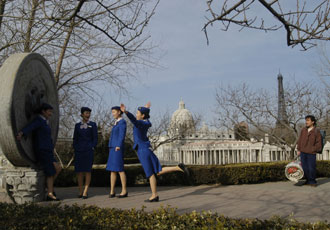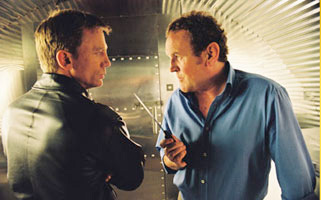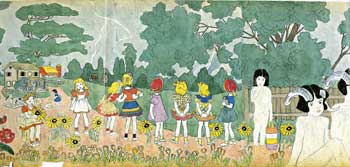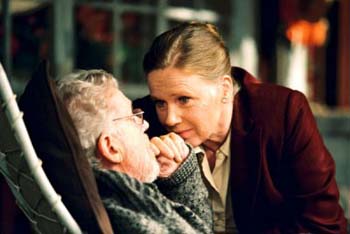
If the unintended recurring theme of 2004's Toronto International Film Festival — or at least the sliver of it that I experienced — was "children in peril," a topic explored to varying degrees of depth by movies like Turtles Can Fly, Nobody Knows, Tarnation, Moolaadé, Stray Dogs, and The Holy Girl, then a number of films at this year's SFIFF cover the relationships, often strained, between parents and their children. It pops up in The Gravel Road, Kings and Queen, The Intruder, Murderball, Saraband, Following Sean, Mouth to Mouth, Brothers, and Boys of Baraka. If we widen the scope to cover generational issues then we can include stories of people dealing with the way life has changed in a generation or two — the fathers dealing with the sons en masse, or vice-versa — a central element of Profiles of Farmers, What's New at Garet?, Days and Hours, Kamancheh, Cinévardaphoto, and even The Power of Nightmares.
Coincidentally, A. O. Scott and Manohla Dargis wrote a few days ago in the New York Times that "paternity was a theme of more than one of this year's winning films" at Cannes. I guess if we define our memes broadly enough, everything fits.
But another more surprising theme in San Francisco's offerings this year — surprising because it seems more esoteric than family relationships — is that of the shrinking world. Many of the character's in this year's films travel without traveling, virtually. They live in an age when geography is no barrier and any place on earth is reachable, or seems for a time like it might be. In films like Hawaii, Oslo, Pilgrimage, Boys of Baraka, The World, The Intruder, Phantom Foreign Vienna, The White Diamond, Innocence, Frank Borzage's revived classic Street Angel, and even the experimental features The Year of Living Vicariously and Tokyo Magic Hour, place is specific in the minds of the characters but abstract in its actual location. It's home, it's Hawaii, it's here, it's anywhere but here. Wherever it is, it's critically important to everyone involved, whether unobtainable or easily reached.
It may be surprising that so many films echo this theme, but I think it's also telling. All of these place-specific movies have an undercurrent of stasis. Often, the theme isn't travel but the lack of it. The world's apparent accessibility is in some sense a hoax, masking the foreignness of distant locales. It's a carrot dangled in front of people who physically or economically may never be able to grasp it. The world seems reachable not because these characters have more mobility than they did in the past, not because they can reach any point on the globe, but because global forces have the power to reach them.
Immigration is part of Pin Boy's back story, but the eponymous character's life is spent sitting in a tiny space dodging heavy objects while listening to coworkers talk about the sights and sounds of places he's never been. In one memorable scene, he stares through the tiny window that separates him from the rest of the bowling alley while his friend is talking about getting out of there. Throughout the movie, it's never clear whether he sees his job in the bowling alley as a stepping stone or a dead-end, but in moments like this, although it's just a long shot of his face, the die seems cast.
In Hawaii, Oslo, the characters append "Oslo" to the name of a meeting place to distinguish it from the island in the Pacific. One man's brother says he lives there — on the island — although his prison-pale complexion seems suspicious. In The Boys of Baraka, documentarians follow a group of "at-risk" boys in Baltimore who participate in a program that sends them to live in remote Kenya for two years in an immersive learning experience that couldn't be more different from the violent neighborhood they come from. The central question asked by one of the boys in a time of distress: "Why can't we do the Baraka school in Baltimore?" Why not, indeed.
Jia Zhangke's The World takes place mostly within a park near Beijing where you can see the world in a day — the Eiffel tower, the Manhattan skyline, the Pyramids of Giza. In Claire Denis' The Intruder, Louis zips from France to Switzerland to South Korea to Tahiti in the blink of an eye and only late in the film begins to realize the distances he still can't cross. In Phantom Foreign Vienna, Lisl Ponger shows one ethnic celebration after another — weddings, dances, rituals — cut together thematically like a globe-trotting Chris Marker essay. But — surprise — the entire 27-minute film was shot in Vienna, exposing a diversity lost in most summaries of the city and a vibrant rhythm of life, just below the surface, that seems unconstrained by political maps.
Even Frank Borzage's 1928 silent film Street Angel, revived by the festival and newly scored by the American Music Club, hinges on the abstraction of place. Home is where you hang your hat. Home is where you've found your love. Home is the imaginary alternate timeline your life might have taken if not for those fateful events. It's a buried theme that the band unearths with a moving, recurring song "Take Me Home" which has troubling complexity both times it's sung, as if home is a place not reachable from here. The live performance of the score included an off-stage trumpet that echoed through the theater with no distinct location, just a cry in the distance like a memory or a dream.
And so on. Film after film.
To the list of films above, I'll add Manoel de Oliveira's A Talking Picture. It wasn't part of the festival but I caught it at the PFA the same week. De Oliveira follows a mother and her daughter as they see the famous sites of the Mediterranean via boat, but half-way through he shifts to listen to the boat's captain as he dines with his favorite passengers, a cosmopolitan roundtable where the diners speak their native tongues but understand each other perfectly. The boat becomes an allegory, but I'll have to see the movie again and think about it some more before I can respond to it more than just viscerally.
In many of these films the geographical theme lies atop — or is it beneath? — the other themes about parents and their children, usually fathers and usually sons. They're stories of freshly connected or long-severed interpersonal links but they're told by conflating physical distance with emotional or spiritual distance. It's a potent metaphor, especially in a visual medium like cinema which shows us a character's thoughts by letting us watch her gestures and the places where they happen. It's also a medium that can take us down the earth's seemingly endless tributaries while we sit motionless in our seats, but that's just the meta-textual bonus we get with our Junior Mints. Like the attractions in Jia Zhangke's theme park, the world's icons on display may very well be painted backdrops and cardboard facades.




